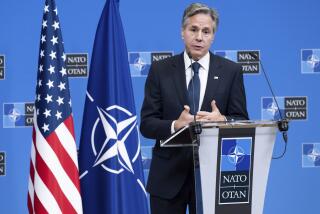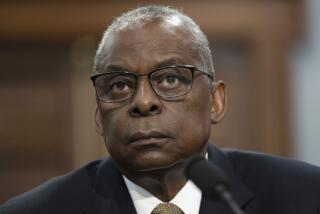China wary of U.S. military moves in Asia-Pacific
WASHINGTON â When a senior U.S. general met in Beijing recently with Lt. Gen. Cai Yingting, the deputy chief of Chinaâs armed forces, Cai forcefully objected to Americaâs expanding military presence in Asia and the Pacific, describing it as an effort to encircle his country.
âWhy are you containing us?â Cai demanded, according to a U.S. official who was present and described the incident in return for anonymity.
The U.S. general denied seeking to contain China, but itâs easy to see why officials in Beijing might get that impression.
The Obama administration is forging closer defense ties to countries near China, including India, Vietnam, the Philippines, Indonesia and Singapore; repositioning troops, planes and ships; and stepping up aid in the South Pacific to offset attention from Beijing.
Defense Secretary Leon E. Panetta is likely to face more sharp questions Monday when he arrives in Beijing for talks with Gen. Liang Guanglie, Chinaâs defense minister, the focal point of a trip that will also take him to Japan and New Zealand.
Panetta is making his first visit to China â but his third trip to the region â since taking over the Pentagon in July 2011, as the administration seeks to shore up alliances and beef up forces to provide a counterweight to Chinaâs growing influence in Asia and the Pacific.
In the latest example, U.S. officials said they hoped to resume visits by Navy warships to New Zealand for the first time since 1984. Even though the South Pacific nation is a close American ally, Washington suspended a mutual defense treaty and most military cooperation with Wellington after it passed a law barring vessels carrying nuclear weapons or using nuclear power in its waters.
U.S. officials said they were exploring whether New Zealand might repeal its ban on nuclear-powered ships, which in the U.S. fleet includes submarines and aircraft carriers. But the Pentagon also is considering changing its policy against sending even nonnuclear Navy vessels to New Zealand.
As a result, Panetta will be the first U.S. Defense secretary to visit New Zealand in more than three decades. A resolution of the long-standing dispute would permit more joint naval exercises and training in the South Pacific, U.S. officials say.
âWeâre in discussions right now, not to bring nuclear weapons to New Zealand but ⦠to help them develop their amphibious capability, which they are very proud of because they consider themselves a southwest Pacific power,â the U.S. official said.
Driving the change is an emerging competition for influence in the South Pacific, where China is cultivating tiny island nations by building roads, harbors and other development projects. Secretary of State Hillary Rodham Clinton two weeks ago attended a regional forum in the far-flung Cook Islands, northeast of New Zealand.
In public, U.S. officials say they are ârebalancingâ forces around the globe now that U.S. troops have left Iraq and are withdrawing from Afghanistan, freeing up military hardware. They say the shift to Asia is aimed not at China, but at the range of security threats, including nuclear-armed North Korea; and at noncombat contingencies, such as humanitarian disasters.
Planners at the Pentagon and at U.S. Pacific Command, which oversees military operations in the region, emphasize that they are not interested in permanent new bases or in a large military footprint. But they are active on multiple fronts.
The Pentagon is reorganizing 9,000 Marines into four task forces to be located in Guam, Hawaii, the Japanese island of Okinawa and, for six-month rotations, at a base on the northern coast of Australia. Three squadrons of F-22 fighters, an advanced jet considered crucial for any engagement with China, will eventually be based in the region.
The Navy will base four new lightly armed ships in Singapore. They will operate in the strategic Strait of Malacca between Malaysia and the Indonesian island of Sumatra, a choke point for the transit of oil and trade, and the energy-rich South China Sea, where territorial jostling between China and other countries has created tension.
The Obama administration is in talks with the Philippine government on regaining access to the Subic Bay naval base and Clark Air Base, two Cold War-era installations on or near the South China Sea. Pentagon planners say they are not interested in returning U.S. military personnel permanently to the Philippines but rather see it as a possible logistics hub, especially for humanitarian supplies.
U.S. Pacific Command hopes to regain access to U-Tapao air base in Thailand, which the U.S. used during the Vietnam War to base B-52 bombers. The current plans call for the United States to help the Thais build a humanitarian assistance center, and eventually rotate U.S. troops in on temporary deployments to train with Thai units, U.S. officials said.
âWe had to reassure them that, no, we are not bringing B-52s back,â a senior official said about the talks with Thailand. âWe have to be very sensitive to the domestic political pressure. Theyâre not allowing us to just come barging in at any time.â
Since the White House announced the shift back to Asia last fall, some analysts have criticized it as more rhetorical than real. An assessment by the Center for Strategic and International Studies, a nonpartisan policy analysis organization in Washington, said the Pentagon still had ânot adequately articulated the strategyâ or explained how it would be achieved with a shrinking defense budget.
âThe top priority of U.S. strategy in Asia is not to prepare for a conflict with China,â the report concluded. âIt is to shape the conflict so that such a conflict is never necessary.â
In a formal response, Panetta said he disagreed with the reportâs finding of a âdisconnect between strategy and resources,â but acknowledged that âbudgeting will be essential to properly execute this strategy.â
Panetta will face a difficult time convincing Chinaâs military leaders that the U.S. buildup isnât aimed at them. When his predecessor, Robert M. Gates, went to Beijing in early 2011, Chinaâs air force conducted the first flight test of an experimental stealth fighter.
The move indicated that the Chinese military establishment sees the two nations more as rivals than as potential partners. So do some within the U.S. government.
More to Read
Sign up for Essential California
The most important California stories and recommendations in your inbox every morning.
You may occasionally receive promotional content from the Los Angeles Times.











